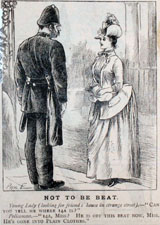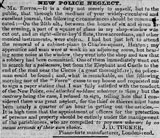Worksheet
Click on any image for a larger view.
Specimen answers/discussion
- The Fun cartoon from 1886 is a play on numbers. Presumably the young lady is looking for her friend but cannot find the house number. The constable takes the number to be that of a colleague, now in plain clothes. There were many jokes about beat officers seeking to charm house-maids after dark and, especially the cooks in gentlemen’s houses. The cooks, it was believed, gave the hungry policeman food from the gentleman’s pantry, or even from his table. Equally, as can be seen from the cartoons in other modules there were representations of the police that were both critical and sympathetic. Cartoons were an element of a free press and can illustrate contrasting attitudes to the police from sections of the public. Generally speaking it is important to recognise and to seek to understand the context in which the cartoon was made – sometimes a moment of tension, sometimes a moment of social peace when the intention was little more than to raise a smile.
- This module has argued that there were differences in the ways in which different groups regarded the police. Since the majority of those people appearing in courts came from the poorer sections of the working class, these groups came under stricter police surveillance than others. They were, for example, more likely to be picked up under the Sus law. This kind of stigma was shifted from the poorest section of the working class to Afro-Caribbean immigrants and their children in the period following the Second World War – not simply by the police, but by a much wider section of society. The problem of preventing crime by singling out suspects, but also avoiding assumptions about who 'looks like' a criminal, is extremely difficult.
- The evidence implies that the first two commissioners were keen that their new force should be noted for its good behaviour and be well-regarded by the population (or at least the articulate part of the population). The scrap books from which these documents were taken suggest that police clerks were employed from early on to scour the press for critical stories and that the commissioners required explanations about the truth of particular stories and what the divisional commander was doing to resolve matters in any area where there had been criticism.
 PC giving directions to a mono-cyclist, Hammersmith, c.1935.
PC giving directions to a mono-cyclist, Hammersmith, c.1935.

